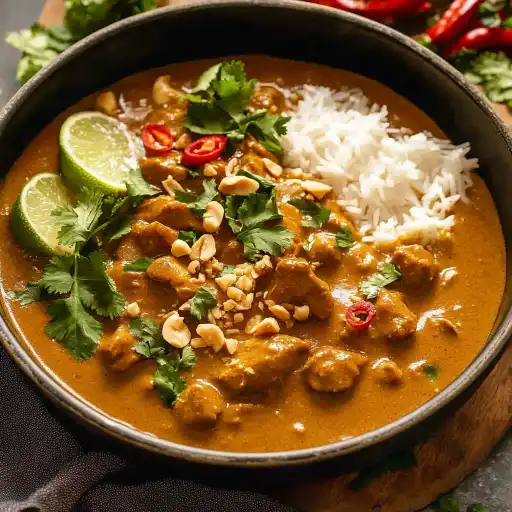Description of this recipe
Chicken Satay Curry is a delectable fusion dish that combines the best of Southeast Asian flavors. It features tender pieces of chicken marinated in a vibrant satay spice blend, then simmered in a rich and creamy peanut-coconut curry sauce. This recipe is a delightful culinary adventure, offering a balance of savory, sweet, and spicy notes.
Why you will love this recipe
You’ll adore this Chicken Satay Curry for its incredible depth of flavor and satisfying textures. The chicken is incredibly tender and infused with aromatic spices, while the sauce is luxuriously creamy and packed with peanutty goodness. It’s a comforting and exotic meal that’s surprisingly easy to make, perfect for a weeknight dinner or a special occasion. Plus, it’s customizable to your spice preference!
Ingredients:
Satay Seasoning
- 1 1/2 tsp coriander powder
- 1 1/2 tsp cumin powder
- 1 1/2 tsp turmeric powder
- 1 1/2 tsp paprika (sweet or normal, not smoked or spicy)
- 1 1/4 tsp chili powder, adjust to taste (not US “Chili Powder”)
- 3 1/2 tsp curry powder, not HOT (any, Malaysian, generic, Clives of India, Keens)
- 1 1/4 tsp salt, cooking/kosher (or 1 tsp table salt)
- 2 tsp white sugar
Chicken
- 750g / 1.5 lb chicken thigh fillets, cut into bite-size pieces
- 1/2 onion (brown, white, or yellow), grated
Satay Sauce
- 2 tbsp oil, separated
- 3 – 6 birds eye chilies or other small hot red chilies, finely chopped
- 1/4 cup onion (brown, white, or yellow), finely diced (~ 1/4 onion)
- 4 garlic cloves, minced
- 1 cup chicken broth/stock
- 3/4 cup peanuts, roasted unsalted, chopped, separated
- 2 tsp kecap manis
- 3 tsp dark soy sauce
- 400g / 14oz coconut milk (preferably full fat but light will be ok)
- 2 tbsp peanut butter, pure best but spread ok too, crunchy or smooth
- 2 tbsp lime juice, to taste
Flavor Infusion – choose ONE:
- 3 makrut lime leaves (formerly kaffir lime leaves)
- 1 lemongrass stalk, white part only, smashed to burst open
Garnish (choices)
- Peanuts, chopped
- Cilantro/coriander leaves
- Fresh chili, finely chopped
Preparation:
Step 1: Combine Satay Seasoning ingredients in a small bowl.
In a bowl, mix the coriander powder, cumin powder, turmeric powder, paprika, chili powder, curry powder, salt, and sugar. Ensure all ingredients are well combined to create a flavorful satay seasoning blend. The aroma of the spices coming together is the first hint of the deliciousness to come.
Step 2: Marinate the Chicken
In a bowl, combine the chicken pieces with 3 1/2 tablespoons of the prepared Satay Seasoning and the grated onion. Mix well, ensuring that each piece of chicken is thoroughly coated in the spice mixture. The grated onion will not only add flavor but also help tenderize the chicken. Cover the bowl and marinate the chicken in the refrigerator for at least 3 hours, or preferably overnight. If you’re short on time, a minimum of 20 minutes will suffice, but the longer the chicken marinates, the more flavorful it will become.
Step 3: Cook the Chicken
Heat 1 tablespoon of oil in a non-stick skillet over high heat. Once the oil is hot, add the marinated chicken in two batches, being careful not to overcrowd the pan. Cook the chicken until it’s browned on all sides but still slightly raw inside. Overcrowding the pan will lower the temperature and cause the chicken to steam instead of sear, so it’s important to cook in batches. Remove the cooked chicken from the skillet and transfer it to a bowl. Cover the bowl to keep the chicken warm.
Step 4: Sauté Aromatics for the Satay Sauce
Using the same skillet, turn the heat down to medium and add the remaining 1 tablespoon of oil. Add the finely chopped chilies, diced onion, and minced garlic cloves to the skillet. Sauté the aromatics until the onion becomes translucent, which should take around 2 minutes. Stir frequently to prevent the garlic from burning. The fragrance of the chilies, onion, and garlic sizzling in the oil is an enticing precursor to the rich flavors of the satay sauce.
Step 5: Create the Satay Sauce Base
Add the remaining Satay Seasoning to the skillet with the sautéed aromatics and cook for 1 minute, stirring constantly. This will help to bloom the spices, intensifying their flavor and releasing their aroma. Be careful not to burn the spices; keep the heat at medium and stir continuously.
Step 6: Blend the Sauce
Transfer the contents of the skillet to a blender or small food processor (a Nutribullet works great for this). Add the chicken stock and 1/2 cup of the chopped peanuts (reserving the rest for later). Puree the mixture until it is relatively smooth. Some peanut chunks can remain for added texture. Blending the sauce at this stage will create a creamy, cohesive base for the satay curry. Pour the blended mixture back into the skillet.
Step 7: Simmer the Satay Curry
Add the remaining 1/4 cup of chopped peanuts, kecap manis, dark soy sauce, coconut milk, and peanut butter to the skillet. Stir well to combine all of the ingredients, ensuring that the peanut butter is fully incorporated into the sauce.
Step 8: Infuse Flavor
Choose either the makrut lime leaves or the lemongrass stalk to infuse the curry with additional flavor. If using makrut lime leaves, crush them slightly in your hand to release their aromatic oils before adding them to the sauce. If using lemongrass, smash the white part of the stalk to burst it open and release its flavor. Add the lime leaves OR lemongrass and the cooked chicken to the sauce.
Step 9: Simmer and Thicken
Bring the sauce to a simmer, then turn the heat down to medium-low. Simmer the curry for 15 minutes, or until the sauce has thickened to your desired consistency. Stir occasionally to prevent the sauce from sticking to the bottom of the skillet. As the curry simmers, the flavors will meld together, creating a rich and complex taste.
Step 10: Finish and Serve
Remove the makrut lime leaves or lemongrass stalk from the curry. Add lime juice to taste, stirring it in to brighten the flavors of the sauce. Taste the curry and adjust the seasoning as needed, adding more salt, sugar, or chili powder to suit your preference. Serve the Chicken Satay Curry hot over rice (jasmine, white rice, or brown rice are all excellent choices). Garnish with chopped peanuts, cilantro/coriander leaves, and fresh chili, if desired.
COOKING Rating:
Medium – This recipe involves a few steps and requires some attention to detail, but it’s not overly complicated and is achievable for most home cooks.
Serving Suggestions:
- Serve with fluffy jasmine rice, white rice, or brown rice.
- Offer a side of steamed vegetables, such as broccoli or green beans.
- A refreshing cucumber salad complements the richness of the curry.
- Garnish with chopped peanuts, fresh cilantro, and sliced chilies.
Tips:
- For a smoother sauce, use creamy peanut butter. For a more textured sauce, use chunky peanut butter.
- If you don’t have kecap manis, you can substitute it with a mixture of dark soy sauce and brown sugar.
- Adjust the amount of chili to your spice preference.
- Marinating the chicken overnight will result in a more flavorful dish.
Prep Time:
20 minutes
Cook Time:
30 minutes
Total Time:
50 minutes (plus marinating time)
Nutritional Information:
(Note: Nutritional information is an estimate and may vary based on specific ingredients and portion sizes)
Calories:
Approximately 550-650 per serving
Protein:
Approximately 35-45 grams per serving
Sodium:
Approximately 800-1000mg per serving
Conclusion
Chicken Satay Curry is a delightful and flavorful dish that’s sure to impress your family and friends. With its tender chicken, creamy peanut-coconut sauce, and aromatic spices, it’s a culinary adventure that’s both comforting and exotic. Whether you’re a seasoned cook or just starting out, this recipe is a must-try for anyone who loves bold, delicious flavors.
Questions and Answers:
Q1: Can I use chicken breast instead of chicken thighs?
A: While chicken thighs are recommended for their tenderness and flavor, you can use chicken breast if you prefer. Just be mindful not to overcook it, as chicken breast tends to dry out more easily than chicken thighs. Cut the chicken breast into bite-sized pieces and follow the recipe instructions.
Q2: I don’t have makrut lime leaves or lemongrass. Can I substitute them with something else?
A: If you don’t have makrut lime leaves or lemongrass, you can omit them without significantly impacting the flavor of the dish. However, if you want to add a similar citrusy note, you can add a teaspoon of lime zest to the sauce along with the lime juice.
Q3: Can I make this recipe vegetarian or vegan?
A: Yes, you can easily adapt this recipe to be vegetarian or vegan. Simply substitute the chicken with tofu or tempeh, cut into bite-sized pieces. Ensure that the tofu is pressed to remove excess water before marinating and cooking. Also, use vegetable broth instead of chicken broth and ensure that your peanut butter is vegan-friendly.
Q4: How long can I store leftovers?
A: Leftover Chicken Satay Curry can be stored in an airtight container in the refrigerator for up to 3-4 days. Reheat gently on the stovetop or in the microwave until heated through.
Q5: Can I freeze this curry?
A: Yes, you can freeze this curry for longer storage. Allow the curry to cool completely before transferring it to an airtight container or freezer bag. Freeze for up to 2-3 months. When ready to serve, thaw the curry in the refrigerator overnight and reheat gently on the stovetop or in the microwave. Be aware that the texture of the sauce may change slightly after freezing and thawing.


